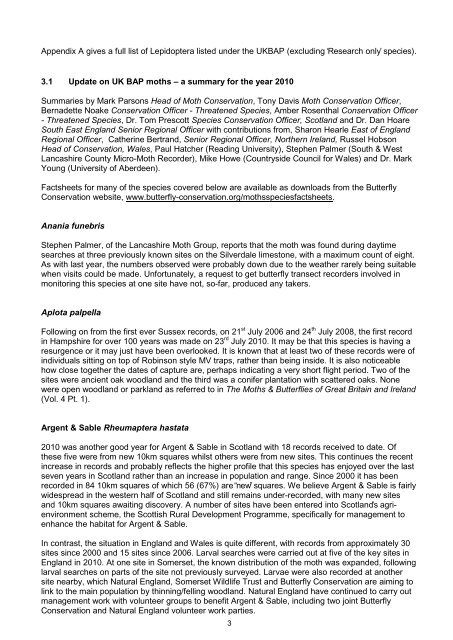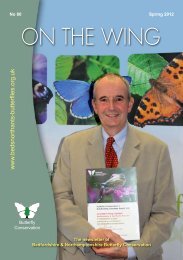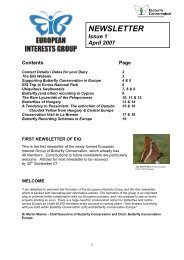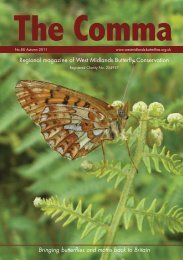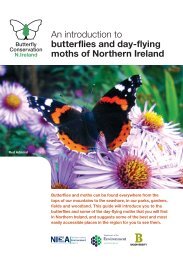Lepidoptera Conservation Bulletin 2011 - Butterfly Conservation
Lepidoptera Conservation Bulletin 2011 - Butterfly Conservation
Lepidoptera Conservation Bulletin 2011 - Butterfly Conservation
Create successful ePaper yourself
Turn your PDF publications into a flip-book with our unique Google optimized e-Paper software.
Appendix A gives a full list of <strong>Lepidoptera</strong> listed under the UKBAP (excluding ‘Research only’ species).<br />
3.1 Update on UK BAP moths – a summary for the year 2010<br />
Summaries by Mark Parsons Head of Moth <strong>Conservation</strong>, Tony Davis Moth <strong>Conservation</strong> Officer,<br />
Bernadette Noake <strong>Conservation</strong> Officer - Threatened Species, Amber Rosenthal <strong>Conservation</strong> Officer<br />
- Threatened Species, Dr. Tom Prescott Species <strong>Conservation</strong> Officer, Scotland and Dr. Dan Hoare<br />
South East England Senior Regional Officer with contributions from, Sharon Hearle East of England<br />
Regional Officer, Catherine Bertrand, Senior Regional Officer, Northern Ireland, Russel Hobson<br />
Head of <strong>Conservation</strong>, Wales, Paul Hatcher (Reading University), Stephen Palmer (South & West<br />
Lancashire County Micro-Moth Recorder), Mike Howe (Countryside Council for Wales) and Dr. Mark<br />
Young (University of Aberdeen).<br />
Factsheets for many of the species covered below are available as downloads from the <strong>Butterfly</strong><br />
<strong>Conservation</strong> website, www.butterfly-conservation.org/mothsspeciesfactsheets.<br />
Anania funebris<br />
Stephen Palmer, of the Lancashire Moth Group, reports that the moth was found during daytime<br />
searches at three previously known sites on the Silverdale limestone, with a maximum count of eight.<br />
As with last year, the numbers observed were probably down due to the weather rarely being suitable<br />
when visits could be made. Unfortunately, a request to get butterfly transect recorders involved in<br />
monitoring this species at one site have not, so-far, produced any takers.<br />
Aplota palpella<br />
Following on from the first ever Sussex records, on 21 st July 2006 and 24 th July 2008, the first record<br />
in Hampshire for over 100 years was made on 23 rd July 2010. It may be that this species is having a<br />
resurgence or it may just have been overlooked. It is known that at least two of these records were of<br />
individuals sitting on top of Robinson style MV traps, rather than being inside. It is also noticeable<br />
how close together the dates of capture are, perhaps indicating a very short flight period. Two of the<br />
sites were ancient oak woodland and the third was a conifer plantation with scattered oaks. None<br />
were open woodland or parkland as referred to in The Moths & Butterflies of Great Britain and Ireland<br />
(Vol. 4 Pt. 1).<br />
Argent & Sable Rheumaptera hastata<br />
2010 was another good year for Argent & Sable in Scotland with 18 records received to date. Of<br />
these five were from new 10km squares whilst others were from new sites. This continues the recent<br />
increase in records and probably reflects the higher profile that this species has enjoyed over the last<br />
seven years in Scotland rather than an increase in population and range. Since 2000 it has been<br />
recorded in 84 10km squares of which 56 (67%) are “new” squares. We believe Argent & Sable is fairly<br />
widespread in the western half of Scotland and still remains under-recorded, with many new sites<br />
and 10km squares awaiting discovery. A number of sites have been entered into Scotland’s agrienvironment<br />
scheme, the Scottish Rural Development Programme, specifically for management to<br />
enhance the habitat for Argent & Sable.<br />
In contrast, the situation in England and Wales is quite different, with records from approximately 30<br />
sites since 2000 and 15 sites since 2006. Larval searches were carried out at five of the key sites in<br />
England in 2010. At one site in Somerset, the known distribution of the moth was expanded, following<br />
larval searches on parts of the site not previously surveyed. Larvae were also recorded at another<br />
site nearby, which Natural England, Somerset Wildlife Trust and <strong>Butterfly</strong> <strong>Conservation</strong> are aiming to<br />
link to the main population by thinning/felling woodland. Natural England have continued to carry out<br />
management work with volunteer groups to benefit Argent & Sable, including two joint <strong>Butterfly</strong><br />
<strong>Conservation</strong> and Natural England volunteer work parties.<br />
3


